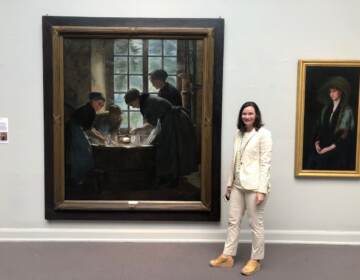PAFA exhibit celebrates the untold history of Philadelphia landscape painting
Without the Schuylkill River School, there may never have been a Hudson River School, says the curator of a Pennsylvania Academy of Fine Arts exhibit.

Thomas Birch, Fairmount Water Works 1821. (Courtesy of the Pennsylvania Academy of the Fine Arts, Philadelphia)
When curator Anna Marley first joined the Pennsylvania Academy of the Fine Arts, she never expected to do a show that focused on the city. She thought it had all been done before.
“Everybody knows everything about Philadelphia and New York and Boston,” Marley said.
But buried in the museum’s permanent collection she found a story that she says hadn’t really been told: There had never been a show about Philadelphia’s influence on American landscape painting.
Philadelphia once served as a beacon of culture in America. The city had the first public museum, the first art school, the first public library. But its influence has long been overshadowed by New York’s rise to prominence, especially when it comes to art.
Marley wants to set the record straight with a new exhibit, titled, “From the Schuylkill to the Hudson: Landscapes of the Early American Republic.” The show features more than 100 pieces from the museum’s permanent collection, with a focus on rural scenes of the Delaware Valley’s waterways from the early 19th century.

Marley especially wanted to highlight the importance of the Schuylkill River in these works.
“One [reason] is that I just love to say Schuylkill and make people who are not from Philadelphia say Schuylkill,” she said. “But the real reason is because in the early republic, it was the Schuylkill River that came to define the idea of the United States to the world.”
The prime example, she said, is an 1821 painting by Thomas Birch of the Fairmount Water Works, which pumped drinking water out of the Schuylkill using hydropower. The painting is accompanied by a graphite print and a china set that depict the same scene.

To Marley, the trio of objects shows that this Philadelphia landscape made its way all over the world. As a result, she said, the Water Works — an impressive feat of engineering at the time, with grandiose Greek Revival columns — became the No. 1 tourist destination in the country.
The painting of Fairmount Water Works inspired the artist Thomas Cole, who was studying in Philadelphia at the time.
“He said he trembled before the landscapes of Thomas Birch,” said Marley. “He saw that painting of the Schuylkill River in 1824 and decided he wanted to become a landscape painter.”
Cole went on to found the much more widely known Hudson River School style of painting, with its majestic landscapes of New York’s Hudson River and the Catskill Mountains. Marley believes there may never have been a Hudson River School without the Schuylkill River School.
Through paintings of the Schuylkill, the Delaware River, and the Wissahickon Creek, as well as maps and sculptures, the show also tells a story about the city’s evolving relationship with its natural resources. These waterways are depicted as a source of drinking water, a means of transportation, and a refuge from urban life.
The exhibition is on view until the end of December.
WHYY is your source for fact-based, in-depth journalism and information. As a nonprofit organization, we rely on financial support from readers like you. Please give today.



